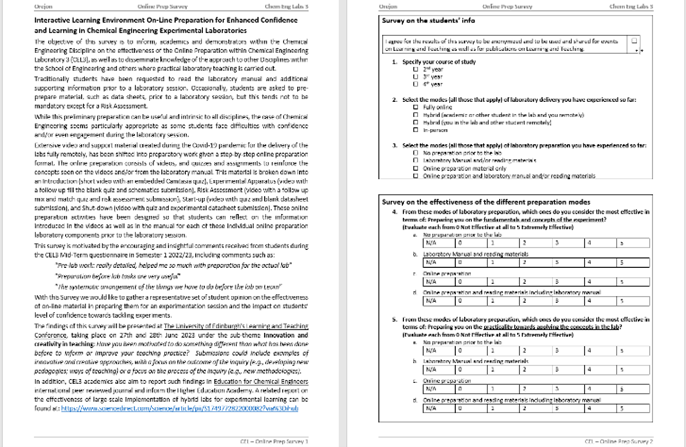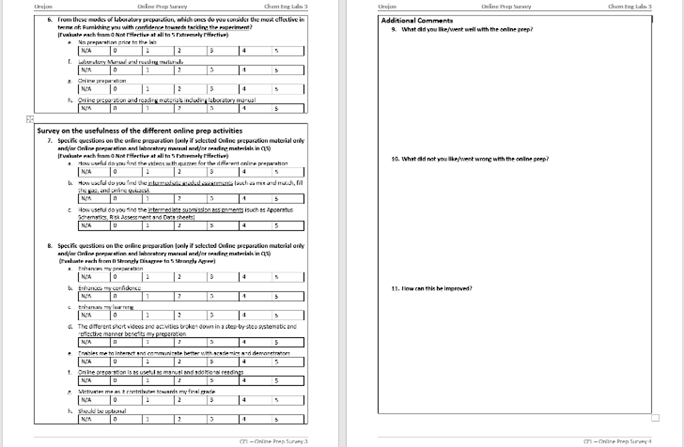
In this insightful post, Dr. Daniel Orejon, a Senior Lecturer in Chemical Engineering at the Institute for Multiscale Thermofluids at The University of Edinburgh, dives into the transformative role of online preparation for laboratory courses. With an impressive background that spans pioneering research in phase-change phenomena and heat transfer, Dr. Orejon brings a rich perspective on integrating practical experience with advanced teaching methodologies. In this blog, he discusses how leveraging digital tools has enhanced the pedagogical framework of Chemical Engineering labs, ensuring students are better equipped and confident in their practical skills. This post belongs to the Jan-March Learning & Teaching Enhancement theme: Engaging and Empowering Learning Engaging and Empowering Learning with Technology.
Online preparation, a must in (chemical) engineering laboratories?
Introduction
In engineering, laboratory courses with practical components meet several purposes: (i) provide students with proficiency management skills and understanding of instrumentation and equipment, (ii) contribute to building personal and professional relationships between students and the teaching team (e.g. academics and demonstrators); and (iii) ease students in effectively securing the relevant fundamental concepts acquired in other concurrent discipline courses. Particularly, our Chemical Engineering Laboratory 3 CEL3 yearlong laboratory course (Degree Regulation and Program of Study here) is one of the richest in terms of practical components and hands-on experimentation within our Chemical Engineering programmes and within the School of Engineering at the UoE. Therefore, preparing for a CEL3 laboratory session may not be as straight forward as in other disciplines and may be overwhelming and challenging for our undergraduate students.
In order to improve our students’ learning experience, preparation and confidence, and motivated by the great amount of digital material created during COVID-19 lockdown in academic year 2020-21 (AY20/21), we developed and implemented in LearnULTRA a step-by-step online preparation for our CEL3 course. Here is how we did it and what we found…
Our Implemented Online Preparation:
Our Chemical Engineering students typically conduct five different in-person experiments in the themes of Heat Transfer, Heat and Mass Transfer, Packed Beds or Fluidised Beds, Reaction and Separation processes. While traditionally our students used to prepare via solely the laboratory manual, our here developed online preparation, on the other hand, consists of videos and interactive activities such as quizzes, fill-in-the-blank and mix-and-match activities and other assignments (e.g. health & safety risk assessments, schematic diagrams) for the Introduction, Experimental Apparatus, Risk Assessment, Start-up, and Shutdown. Thus, the online preparation has been methodologically designed and implemented in a step-by-step interactive and reflective fashion to encourage students’ preparation and engagement, learning, confidence and self-reflection. Figure 1 includes the main steps of the online preparation we implemented in CEL3 at the UoE.
A video showing how to complete the online preparation can be found in the link ‘here’.

Original figure and more details can be found in Orejon et al., Education for Chemical Engineers 50, pp. 59-71, 2025.
A video showing how to complete the online preparation can be found in the link to: ‘A video explaining the different steps necessary to navigate and complete the online experience’.
Our survey
We then run a Survey to understand the usefulness and effectiveness of our proposed interactive online preparation prior to an experimentation session, which is included in Figure 2. More in particular, we evaluated the impact of the online preparation on the students’ learning experience and level of confidence towards tackling hands-on experimentation or practical work for the very last (fifth) laboratory session of our CEL3 AY22/23 cohort.


Original figure and more details can be found in Orejon et al., Education for Chemical Engineers 50, pp. 59-71, 2025.
Besides providing the students with the main motivation behind it, the survey included a series of closed questions to understand the different students’ background and a series of a six point Likert scale to assess the students’ representative opinion on how the different modes of preparation (no preparation, laboratory manual, online preparation, and online preparation + laboratory manual) influenced our students’ learning of fundamentals, practice and confidence, prior to a laboratory session. In addition, three open questions providing additional feedback were also available.
What we found:
When asking our students “How the different preparation modes that they have experienced so far prior to a practical hands-on laboratory session furnished them with fundamentals, practice and confidence?”, a clear increase in the ‘effectiveness’ (4-Very Effective and 5-Extremley effective) in either fundamentals, practice or confidence was observed when progressively moving from no preparation at all , to preparation via the laboratory manual, to online preparation and finally to online preparation + laboratory manual for any of the treats considered, as represented in Figure 3.

Original figure and more details can be found in Orejon et al., Education for Chemical Engineers 50, pp. 59-71, 2025.
Compared to the previous sole use of the laboratory manual on its own as the way to prepare for the laboratory activities, we clearly observe a 2-to-3-fold increase in the satisfaction or effectiveness reported by our students after the implementation of the online preparation. In other words, nearly 90% of our students agreed that the online preparation reinforces their fundamentals knowledge, practice and confidence after combining both the laboratory manual and the implemented online preparation.
Moreover, we did also evaluate the student’s opinion in other important aspects of the online activities implemented. Our students really enjoyed the mix-and-match and fill-in-the-gap activities as well as the quizzes embedded within the videos, while they found the different submission assignments (Experimental Apparatus Schematics, Risk Assessment, and Start-up and Shut-down Data Sheets) less effective by only 35% of our CEL3 cohort. We believe that the low satisfaction in this latter item is attributed to the more time-consuming nature of the assignments while no associated direct instantaneous formative feedback or grades are provided for these submissions.
In addition to the direct impact of the online preparation on our students’ learning experience, practice and confidence, we were also very much interested in other more general traits of the online preparation. To this end the students’ perception towards: whether the step-by-step design of the online preparation enhances students’ preparation and reflection, whether it enhances the interaction and communication with academics, and/or whether it should be optional, were evaluated, with responses in Figure 4:

Original figure and more details can be found in Orejon et al., Education for Chemical Engineers 50, pp. 59-71, 2025.
Overall, more than 70% of our CEL3 students’ cohort considered that the careful step-by-step design of the online preparation (including direct feedback and space for self-reflection prior to some of the quizzes and activities) benefited their preparation and reflection when compared to earlier preparation methods. More than half of our CEL3 students’ cohort also agreed that they felt more prepared to interact and communicate with academics and demonstrators during the in-person laboratory session, while 90% of our CEL3 students’ considered that the online preparation should be a mandatory element prior to laboratory experimentation.
Last, it was very reassuring to learn that students enjoyed the course and that they were able to fully engage with the newly implemented online preparation during the whole academic year AY22/23, which was confirmed by some of the open answers received on What Went Well such as:
- “It gives a good understanding of an upcoming lab and I have a chance to get familiar with materials.”
- “Watching prep video, we can better understand what are we going to do in a lab. See the apparatus and valves/buttons we are practically going to change. Really helpful.”
- “Makes you feel ready for the experiment.”
- “It gives a good understanding of an upcoming lab and I have a chance to get familiar with materials.”
- “The information was broken down nicely into sections. The videos were fairly clear and well presented.”.
Conclusion
In conclusion, we are very pleased to learn on the superior and more effective learning experience undertaken by our CEL3 AY22/23 students’ cohort via the implementation of the here developed step-by-step online preparation including videos, quizzes, interactive activities and assignments. In addition to the videos, the intermediate interactive activities (quizzes, mix and match, fill in the blank, etc.) and assignments. These provided our students with the necessary tools and space for learning and reflection ultimately preparing them better for a laboratory session. Last, we believe that other engineering and/or social science disciplines may also benefit from such online preparation.
If you want to know more details, the findings reported above have been accepted for publication in Education for Chemical Engineers Elsevier journal in the following link: 10.1016/j.ece.2024.12.004
Acknowledgments
First of all, the biggest thanks go to our CEL3 AY22/23 students’ cohort. In addition, a big thanks goes to all the members of the Chemical Engineering CEL3 labs Team (Harvey, Nacho, Glen, Tayebeh, Simona, Franziska, Seb, Luke, Fraz, Valentine, Gordon, Hannah, and others) and to Summer Internship student Hannah Linden who has created all the online quizzes and other additional interactive activities.
Other useful online resources:
Degree Regulations & Programme of Study Undergraduate Course Chemical Engineering Laboratory 3 CHEE09016: http://www.drps.ed.ac.uk/23-24/dpt/cxchee09016.htm
A video explaining the different steps necessary to navigate and complete the online experience can be found in the following link: https://media.ed.ac.uk/media/20200925-WorkflowOnlineExperiment/1_p6f0gzve
Our earlier blog on Adaptation of the Chemical Engineering Laboratory 3 to online and hybrid teaching https://www.teaching-matters-blog.ed.ac.uk/adaptation-of-the-chemical-engineering-laboratory-3-to-online-and-hybrid-teaching/
The online preparation methodology and findings were presented at the Learning and Teaching Conference at the University of Edinburgh in 2023 as: Interactive Learning Environment On-Line Preparation for Enhanced Confidence and Learning in Chemical Engineering Experimental Laboratories (https://blogs.ed.ac.uk/learning-teaching-conference-2023/wp-content/uploads/sites/8452/2023/08/B1.2-20230628-Orejon-LT-Presentation-1.pdf)
The online preparation methodology and findings were also presented Practical Engineering Education 24 PEE24 at the University of Sheffield in 2024 as: Enhanced Confidence and Learning in Practical Chemical Engineering via Online Preparation (https://pee2024.sites.sheffield.ac.uk/programme)
 Dani Orejon
Dani Orejon
Daniel Orejon (Dani) is a Senior Lecturer in Chemical Engineering at the Institute for Multiscale Thermofluids (IMT) at The University of Edinburgh in UK and Associate Visiting Professor at Kyushu University Japan since 2019. Dani completed his PhD on the fundamentals of evaporation phase-change at the droplet scale, both during free evaporation and under external forces applied in 2013. Thereafter he joined the International Institute for Carbon-Neutral Energy Research (WPI-I2CNER) at Kyushu University in Japan as a Post-Doctoral Research Associate and then as an Assistant Professor where he shifted his research efforts towards condensation phase-change and heat transfer on micro- and nano-structured surfaces while continuing his research interests and collaborations on droplet evaporation. In addition, Dani is the Deputy Head of the Engineering Graduate School at the School of Engineering, Teaching Laboratory Manager for the Chemical Engineering Discipline, and is an Advance HE Fellow since April 2021.


